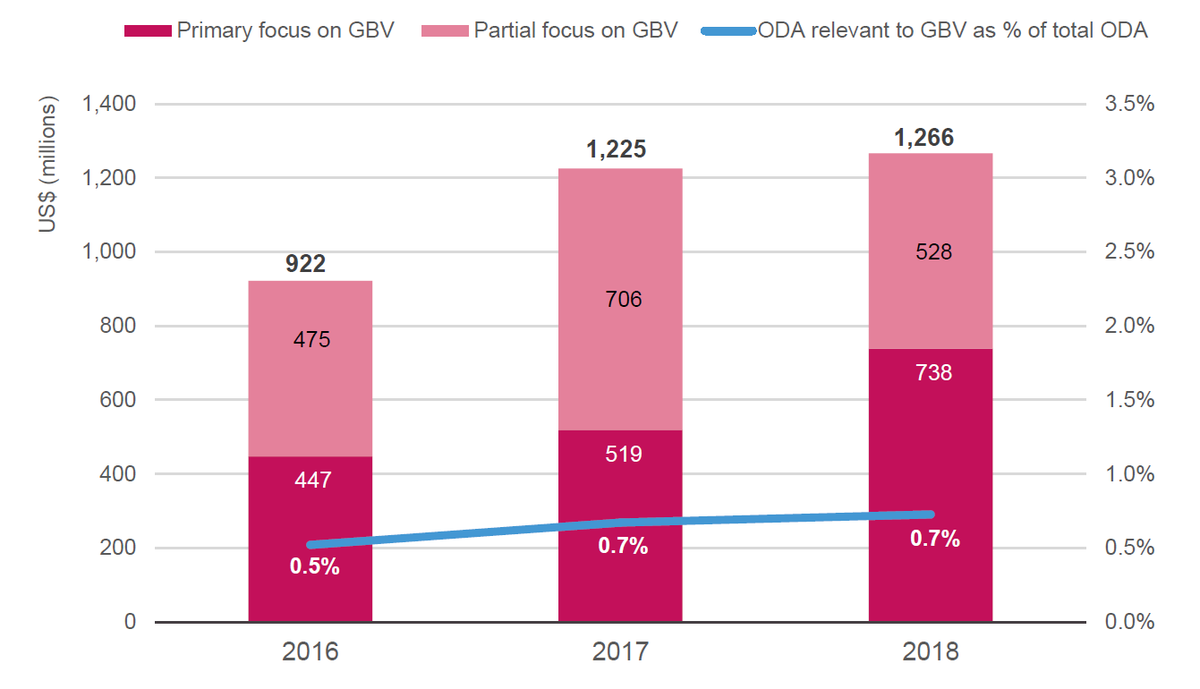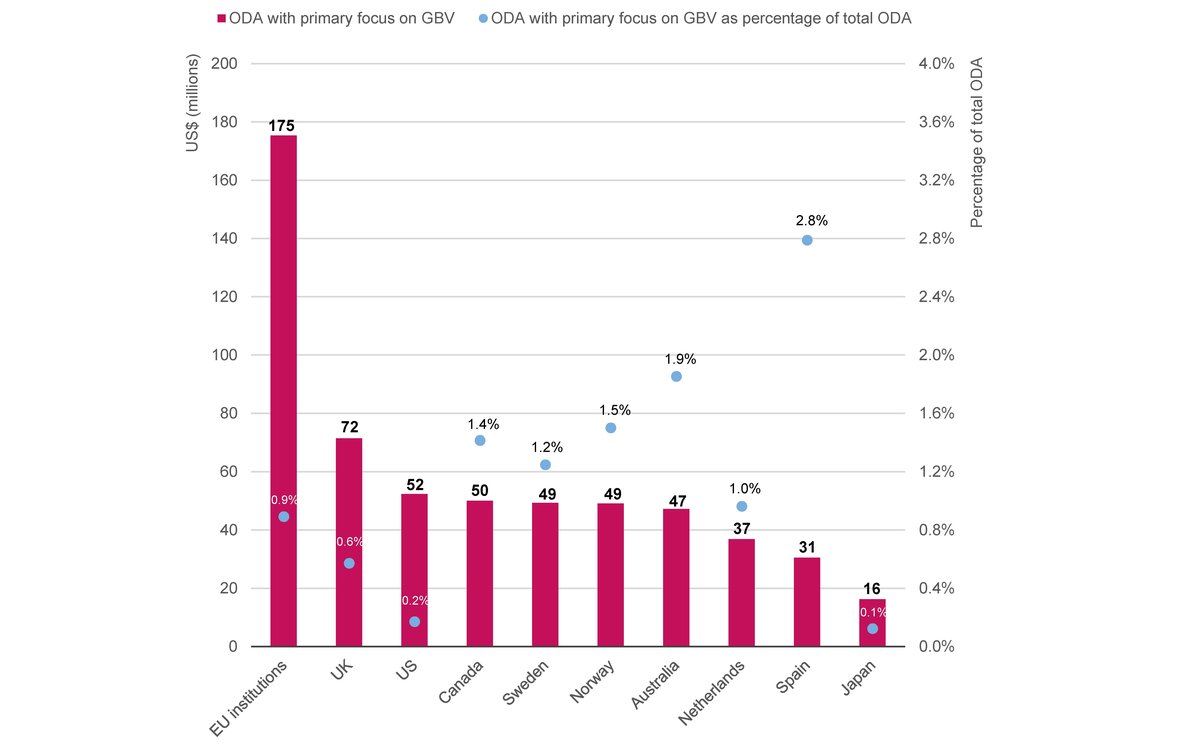How to track ODA to gender-based violence (GBV) responses
Amanda Thomas and Carina Chicet outline how we can use a keyword methodology to track ODA to gender-based violence (GBV) responses, and ensure more transparent reporting.
Around 35% of women worldwide have experienced physical and/or sexual violence by a partner or non-partner. Gender-based violence (GBV) is exacerbated in humanitarian crises , like the Covid-19 pandemic . In fact, GBV is just one element of wider gender inequalities that tend to be compounded in times of crisis.
However, poor reporting can make it difficult to understand how much official development assistance (ODA) is targeted at GBV. That’s why, in 2016, the OECD Development Assistance Committee (DAC) Creditor Reporting System (CRS) introduced a new ‘ending violence against women and girls’ purpose code. This code aims to monitor aid to GBV to help hold governments accountable for delivering on relevant Sustainable Development Goals (SDG) targets.
While the introduction of the purpose code is an important step towards tracking spending in this area, reporting using the code is voluntary. It also takes time for new codes to be adopted and applied consistently. This makes it difficult to gain an accurate picture of ODA spending on GBV.
In order to create a clearer picture of current spending, we combined existing data from the new voluntary purpose code with flows from the CRS. These were identified using a keyword search methodology, where multiple sets of keywords and phrases were searched against project records to flag those with a primary or partial focus on GBV.
Our analysis: a keyword methodology and gender-based violence (GBV)
Our analysis found that less than 1% of ODA is targeted at gender-based violence (GBV) responses. However, ODA reported under the new GBV purpose code more than tripled in three years – from US$138 million in 2016 to US$427 million in 2018.
This spike was largely due to a significant increase in EU funding for GBV connected with the EU-UN Spotlight Initiative – a €500 million multi-year joint commitment to prevent and respond to violence against women and girls in more than 25 countries. This was also highlighted in our report Gender-based violence and the nexus: global lessons from the Syria response for financing, policy and practice .
While reporting to the new purpose code increased, a substantial amount of funding for GBV prevention and response did not use it. The keyword search analysis showed that an additional US$300 million in aid was targeted at GBV prevention and response activities each year, but not marked accordingly. This reflects the differences in reporting between DAC donors, with the code not being used consistently.
Over the three-year period 2016–2018, US$475 million to US$528 million was identified as having a partial focus on GBV (Figure 1). This included funding for projects that might be part of a wider programme of work or cross-cutting area, where a clear separation of GBV activities might not be possible due to reporting gaps and inconsistencies.
Together, the primary and partial categories totalled close to US$1.3 billion in aid relevant to GBV in 2018. This represents a gradual increase since 2016, when reporting under the specific purpose code was first introduced. However, the amount represents just a small share of total ODA allocations.
Figure 1: ODA relevant to gender-based violence has increased gradually since 2016
ODA relevant to GBV, 2016–2018

The majority of ODA relevant to gender-based violence is focused on making a principal contribution to gender equality
Source: Development Initiatives based on OECD Development Assistance Committee (DAC) Creditor Reporting System (CRS).
Notes: ODA = official development assistance. GBV = gender-based violence. Data is in constant 2018 prices. Included in the analysis of ODA relevant to GBV are projects reported to the CRS by donors and coded with the purpose code 15180 – ending violence against women and girls – and flows identified by keyword search as having a primary or partial focus on GBV. Total ODA refers to total gross bilateral ODA as recorded in the CRS.
The increase in funding targeted at GBV is mirrored in the data published to the International Aid Transparency Initiative (IATI). Data reported to date shows that funding to GBV has increased every year since 2016.
There is some evidence to suggest that this trend will continue. Some key multilateral organisations, including the United Nations Development Programme, UN Women and UNICEF, have reported significantly increased commitments for GBV in 2020 compared with 2019. However, it is still too early to see how these commitments will translate into actual disbursements.
There are substantial differences between the amounts allocated by the top ten donors of ODA relevant to GBV (Figure 2). The EU is by far the single largest donor, continuing to fund significant efforts to address GBV, such as the EU-UN Spotlight Initiative.
However, for most donors, funding to GBV-related projects only comprises a small percentage of their total ODA. The top three donors of ODA relevant to GBV – the EU, UK and US; also the top donors of total ODA in 2018 – allocated between just 0.2% (the US) and 0.9% (the EU) of their ODA to projects with a primary focus on GBV.
Figure 2: The EU was the single largest donor of ODA with a primary focus on gender-based violence in 2018
Top 10 DAC donors of ODA relevant to GBV, 2018

The EU was the single largest donor of ODA with a primary focus on gender-based violence in 2018
Source: Development Initiatives based on OECD DAC CRS.
Notes: ODA = official development assistance. GBV = gender-based violence. Data is in constant 2018 prices. Included in the analysis of ODA relevant to GBV are projects reported to the CRS by donors and coded with the purpose code 15180 – ending violence against women and girls – and flows identified by keyword search as having a primary focus on GBV. Total ODA refers to total gross bilateral ODA as recorded in the CRS. The EU is a member of the OECD DAC.
Another way we analysed ODA expenditure relating to gender equality is by looking at the OECD DAC Gender Equality Policy Marker (GEM), with projects marked as significant and principal counted as gender equality focused aid by the DAC .
This allows us to see that the majority (78% or US$579 million) of ODA with a primary focus on GBV allocated a principal contribution to gender equality in 2018 (Figure 3). A further 18% (US$133 million) allocated a significant contribution to gender equality in the same year.
This shows that GBV-relevant projects reported on the CRS focused on gender equality explicitly, as the primary objective of the project. This is opposed to ‘mainstreaming’ it, which means promoting gender equality as a project outcome.
Reporting under the GEM has also improved over the three-year period 2016–2018, with 97% of projects that were GBV relevant were marked as making either a principal or significant contribution to gender equality. Only 3% (US$21 million) of projects that were GBV relevant were marked as not targeting gender equality in 2018.
Figure 3: The majority of ODA relevant to gender-based violence is focused on making a principal contribution to gender equality
Allocation of ODA relevant to GBV using the OECD DAC Gender Equality Policy Marker, 2016–2018

The majority of ODA relevant to gender-based violence is focused on making a principal contribution to gender equality
Source: Development Initiatives based on OECD DAC CRS.
Notes: Data is in constant 2018 prices. Included in the analysis of ODA relevant to GBV are projects reported to the CRS by donors and coded with the purpose code 15180 – ending violence against women and girls – and flows identified by keyword search as having a primary focus on GBV. OECD DAC Gender Equality Policy Marker includes the following categories: 2 (principal contribution), 1 (significant contribution), 0 (gender not targeted), and not screened (i.e. left blank).
Our recommendations: towards more comprehensive GBV reporting
Historically, it has been difficult to capture data on aid spending on gender-based violence (GBV), as most projects focus on it as a sub-component, or cross-cutting issue, as opposed to an explicit focus.
To improve this, reporting of funding under multiple purpose codes should be made more comprehensive. In general, Development Assistance Committee (DAC) donors should improve their reporting of relevant purpose codes and markers, including those related to GBV.
This will help ensure more accurate and transparent reporting of funding to support better-targeted and gender-responsive development programming. This is particularly pertinent in the current crisis of the Covid-19 pandemic – where existing gendered inequalities are compounded and GBV exacerbated.
Download the dataset
How to track ODA to gender-based violence (GBV) responses (excel download)
Related content
Global Humanitarian Assistance Report 2020
The Global Humanitarian Assistance Report 2020 frames the crisis financing landscape. It provides a detailed picture of humanitarian needs and financing in 2019 alongside unique analysis of crisis financing to the Covid-19 (coronavirus) pandemic response.
What impact will Covid-19 have on development finance?
This podcast expands on our latest projections of the impact Covid-19 will have on development finance, including all forms of finance from direct investment and domestic revenue to tourism receipts and remittances.
Gender-based violence and the nexus: global lessons from the Syria crisis response for financing, policy and practice
How the global response to GBV can be strengthened by the humanitarian-development-peace nexus. With lessons from the crisis in Syria. Written by Sarah Hanssen, with support from DI's Carina Chicet